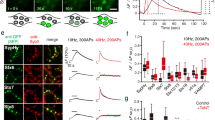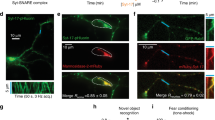Abstract
Synaptic plasticity is dependent on the differential sorting, delivery and retention of neurotransmitter receptors, but the mechanisms underlying these processes are poorly understood. We found that differential sorting of glutamate receptor subtypes began in the endoplasmic reticulum of rat hippocampal neurons. As AMPA receptors (AMPARs) were trafficked to the plasma membrane via the conventional somatic Golgi network, NMDA receptors (NMDARs) were diverted from the somatic endoplasmic reticulum into a specialized endoplasmic reticulum subcompartment that bypasses somatic Golgi, merging instead with dendritic Golgi outposts. This endoplasmic reticulum subcompartment was composed of highly mobile vesicles containing the NMDAR subunits NR1 and NR2B, the microtubule-dependent motor protein KIF17, and the postsynaptic adaptor proteins CASK and SAP97. Our data demonstrate that the retention and trafficking of NMDARs in this endoplasmic reticulum subcompartment requires both CASK and SAP97. These findings indicate that NMDARs are sorted away from AMPARs via a non-conventional secretory pathway that utilizes dendritic Golgi outposts.
This is a preview of subscription content, access via your institution
Access options
Subscribe to this journal
Receive 12 print issues and online access
$209.00 per year
only $17.42 per issue
Buy this article
- Purchase on Springer Link
- Instant access to full article PDF
Prices may be subject to local taxes which are calculated during checkout







Similar content being viewed by others
References
Dumas, T.C. Developmental regulation of cognitive abilities: modified composition of a molecular switch turns on associative learning. Prog. Neurobiol 76, 189–211 (2005).
Malinow, R. & Malenka, R.C. AMPA receptor trafficking and synaptic plasticity. Annu. Rev. Neurosci. 25, 103–126 (2002).
Malenka, R.C. & Bear, M.F. LTP and LTD: an embarrassment of riches. Neuron 44, 5–21 (2004).
Rao, A., Kim, E., Sheng, M. & Craig, A.M. Heterogeneity in the molecular composition of excitatory postsynaptic sites during development of hippocampal neurons in culture. J. Neurosci. 18, 1217–1229 (1998).
Friedman, H.V., Bresler, T., Garner, C.C. & Ziv, N.E. Assembly of new individual excitatory synapses: time course and temporal order of synaptic molecule recruitment. Neuron 27, 57–69 (2000).
Washbourne, P., Bennett, J.E. & McAllister, A.K. Rapid recruitment of NMDA receptor transport packets to nascent synapses. Nat. Neurosci. 5, 751–759 (2002).
Montgomery, J.M., Zamorano, P.L. & Garner, C.C. MAGUKs in synapse assembly and function: an emerging view. Cell. Mol. Life Sci. 61, 911–929 (2004).
Kennedy, M.J. & Ehlers, M.D. Organelles and trafficking machinery for postsynaptic plasticity. Annu. Rev. Neurosci. 29, 325–362 (2006).
Greger, I.H. & Esteban, J.A. AMPA receptor biogenesis and trafficking. Curr. Opin. Neurobiol. 17, 289–297 (2007).
Park, M., Penick, E.C., Edwards, J.G., Kauer, J.A. & Ehlers, M.D. Recycling endosomes supply AMPA receptors for LTP. Science 305, 1972–1975 (2004).
Yudowski, G.A. et al. Real-time imaging of discrete exocytic events mediating surface delivery of AMPA receptors. J. Neurosci. 27, 11112–11121 (2007).
Cognet, L., Groc, L., Lounis, B. & Choquet, D. Multiple routes for glutamate receptor trafficking: surface diffusion and membrane traffic cooperate to bring receptors to synapses. Sci. STKE 2006, pe13 (2006).
Sheng, M. & Hoogenraad, C.C. The postsynaptic architecture of excitatory synapses: a more quantitative view. Annu. Rev. Biochem. 76, 823–847 (2006).
Setou, M., Nakagawa, T., Seog, D.H. & Hirokawa, N. Kinesin superfamily motor protein KIF17 and mLin-10 in NMDA receptor-containing vesicle transport. Science 288, 1796–1802 (2000).
Sans, N. et al. Synapse-associated protein 97 selectively associates with a subset of AMPA receptors early in their biosynthetic pathway. J. Neurosci. 21, 7506–7516 (2001).
Wyszynski, M. et al. Interaction between GRIP and liprin-alpha/SYD2 is required for AMPA receptor targeting. Neuron 34, 39–52 (2002).
Guillaud, L., Setou, M. & Hirokawa, N. KIF17 dynamics and regulation of NR2B trafficking in hippocampal neurons. J. Neurosci. 23, 131–140 (2003).
Lisé, M.F. et al. Involvement of myosin Vb in glutamate receptor trafficking. J. Biol. Chem. 281, 3669–3678 (2006).
Setou, M. et al. Glutamate receptor-interacting protein GRIP1 directly steers kinesin to dendrites. Nature 417, 83–87 (2002).
Perestenko, P.V. & Henley, J.M. Characterization of the intracellular transport of GluR1 and GluR2 alpha-amino-3-hydroxy-5-methyl-4-isoxazole propionic acid receptor subunits in hippocampal neurons. J. Biol. Chem. 278, 43525–43532 (2003).
Sans, N. et al. NMDA receptor trafficking through an interaction between PDZ proteins and the exocyst complex. Nat. Cell Biol. 5, 520–530 (2003).
Sans, N. et al. mPins modulates PSD-95 and SAP102 trafficking and influences NMDA receptor surface expression. Nat. Cell Biol. 7, 1179–1190 (2005).
Bassand, P., Bernard, A., Rafiki, A., Gayet, D. & Khrestchatisky, M. Differential interaction of the tSXV motifs of the NR1 and NR2A NMDA receptor subunits with PSD-95 and SAP97. Eur. J. Neurosci. 11, 2031–2043 (1999).
Gardoni, F. et al. CaMKII-dependent phosphorylation regulates SAP97/NR2A interaction. J. Biol. Chem. 278, 44745–44752 (2003).
Mauceri, D., Gardoni, F., Marcello, E. & Di Luca, M. Dual role of CaMKII-dependent SAP97 phosphorylation in mediating trafficking and insertion of NMDA receptor subunit NR2A. J. Neurochem. 100, 1032–1046 (2007).
Pierce, J.P., Mayer, T. & McCarthy, J.B. Evidence for a satellite secretory pathway in neuronal dendritic spines. Curr. Biol. 11, 351–355 (2001).
Pfeffer, S. Membrane domains in the secretory and endocytic pathways. Cell 112, 507–517 (2003).
Dascher, C. & Balch, W.E. Dominant inhibitory mutants of ARF1 block endoplasmic reticulum to Golgi transport and trigger disassembly of the Golgi apparatus. J. Biol. Chem. 269, 1437–1448 (1994).
Horton, A.C. & Ehlers, M.D. Dual modes of endoplasmic reticulum-to-Golgi transport in dendrites revealed by live-cell imaging. J. Neurosci. 23, 6188–6199 (2003).
Schuman, E.M., Dynes, J.L. & Steward, O. Synaptic regulation of translation of dendritic mRNAs. J. Neurosci. 26, 7143–7146 (2006).
Bannai, H., Inoue, T., Nakayama, T., Hattori, M. & Mikoshiba, K. Kinesin-dependent, rapid, bi-directional transport of ER subcompartment in dendrites of hippocampal neurons. J. Cell Sci. 117, 163–175 (2004).
Mironov, S.L. & Symonchuk, N. ER vesicles and mitochondria move and communicate at synapses. J. Cell Sci. 119, 4926–4934 (2006).
Jo, K., Derin, R., Li, M. & Bredt, D.S. Characterization of MALS/Velis-1, -2, and -3: a family of mammalian LIN-7 homologs enriched at brain synapses in association with the postsynaptic density–95/NMDA receptor postsynaptic complex. J. Neurosci. 19, 4189–4199 (1999).
Butz, S., Okamoto, M. & Sudhof, T.C. A tripartite protein complex with the potential to couple synaptic vesicle exocytosis to cell adhesion in brain. Cell 94, 773–782 (1998).
Lee, S., Fan, S., Makarova, O., Straight, S. & Margolis, B. A novel and conserved protein-protein interaction domain of mammalian Lin-2/CASK binds and recruits SAP97 to the lateral surface of epithelia. Mol. Cell. Biol. 22, 1778–1791 (2002).
Leonoudakis, D., Conti, L.R., Radeke, C.M., McGuire, L.M. & Vandenberg, C.A. A multiprotein trafficking complex composed of SAP97, CASK, Veli and Mint1 is associated with inward rectifier Kir2 potassium channels. J. Biol. Chem. 279, 19051–19063 (2004).
Tiffany, A.M. et al. PSD-95 and SAP97 exhibit distinct mechanisms for regulating K+ channel surface expression and clustering. J. Cell Biol. 148, 147–158 (2000).
Leonard, A.S., Davare, M.A., Horne, M.C., Garner, C.C. & Hell, J.W. SAP97 is associated with the alpha-amino-3-hydroxy-5-methylisoxazole-4-propionic acid receptor GluR1 subunit. J. Biol. Chem. 273, 19518–19524 (1998).
Nakagawa, T. et al. Quaternary structure, protein dynamics and synaptic function of SAP97 controlled by L27 domain interactions. Neuron 44, 453–467 (2004).
Dotti, C.G. & Poo, M.M. Neuronal polarization: building fences for molecular segregation. Nat. Cell Biol. 5, 591–594 (2003).
Dresbach, T. et al. Assembly of active zone precursor vesicles: obligatory trafficking of presynaptic cytomatrix proteins Bassoon and Piccolo via a trans-Golgi compartment. J. Biol. Chem. 281, 6038–6047 (2006).
Tang, B.L. Protein trafficking mechanisms associated with neurite outgrowth and polarized sorting in neurons. J. Neurochem. 79, 923–930 (2001).
Claudio, T. Stable expression of heterologous multisubunit protein complexes established by calcium phosphate– or lipid-mediated cotransfection. Methods Enzymol. 207, 391–408 (1992).
Banker, G. & Goslin, K. Developments in neuronal cell culture. Nature 336, 185–186 (1988).
Ho, S.N., Hunt, H.D., Horton, R.M., Pullen, J.K. & Pease, L.R. Site-directed mutagenesis by overlap extension using the polymerase chain reaction. Gene 77, 51–59 (1989).
Wu, H., Reuver, S.M., Kuhlendahl, S., Chung, W.J. & Garner, C.C. Subcellular targeting and cytoskeletal attachment of SAP97 to the epithelial lateral membrane. J. Cell Sci. 111, 2365–2376 (1998).
Bresler, T. et al. Postsynaptic density assembly is fundamentally different from presynaptic active zone assembly. J. Neurosci. 24, 1507–1520 (2004).
Phend, K.D., Rustioni, A. & Weinberg, R.J. An osmium-free method of epon embedment that preserves both ultrastructure and antigenicity for post-embedding immunocytochemistry. J. Histochem. Cytochem. 43, 283–292 (1995).
Fujisawa, S. & Aoki, C. In vivo blockade of N-methyl-D-aspartate receptors induces rapid trafficking of NR2B subunits away from synapses and out of spines and terminals in adult cortex. Neuroscience 121, 51–63 (2003).
Leal-Ortiz, S. et al. Piccolo modulation of Synapsin1a dynamics regulates synaptic vesicle exocytosis. J. Cell Biol. 181, 831–846 (2008).
Acknowledgements
We would like to thank S. Leal-Ortiz for assistance with the generation of lentivirus and shRNA, L.A. Needleman and J. Marks. Also, thanks to B. Margolis for the CASK constructs, J. Lippincott-Schwartz for the Galtase-GFP construct and V. Bindokas for help and advice with imaging protocols. This work was supported by the Nancy Pritzker Family and US National Institutes of Health grant DA016758 to C.C.G., a Deutsche Forschungsgemeinschaft postdoctoral fellowship to C.G.S., The Marsden Fund (Royal Society of New Zealand) to J.M.M., US National Institutes of Health grants NS043782, DA13602 and DA019695 to W.N.G., and the Albert & Ellen Grass Faculty Award to W.N.G. and J.M.
Author information
Authors and Affiliations
Contributions
O.J. conducted the majority of the experiments and data analysis and co-wrote the manuscript. C.L.W. contributed to the shRNA experiments and helped in the editing of the manuscript. C.G.S. designed, constructed and aided in the testing of the shRNAs. S.F. performed the electron microscopy studies. M.S. carried out temperature block, BFA and some of the live-imaging experiments. E.L. performed flow cytometry experiments. J.M. provided advice and aided in the interpretation of data. C.A. supervised the electron microscopy studies. T.d.S. assisted with the temperature block experiments. J.M.M. supervised and designed studies and helped with the editing of the manuscript. C.C.G. and W.N.G. supervised the project and co-wrote the manuscript.
Corresponding authors
Supplementary information
Supplementary Text and Figures
Supplementary Figures 1–7 and Supplementary Results (PDF 936 kb)
Supplementary Video 1
Movement of a vesicle containing RFP-SAP97 and NR1-GFP. E18 hippocampal neurons were transfected at 14 DIV with RFP-SAP97 (left) and NR1-GFP (right). Time-lapse imaging was performed at 1 d post-transfection and image frames were acquired every 5 s for 2 min. The frame sequence highlights the image field displayed in Figure 4c. (MOV 305 kb)
Rights and permissions
About this article
Cite this article
Jeyifous, O., Waites, C., Specht, C. et al. SAP97 and CASK mediate sorting of NMDA receptors through a previously unknown secretory pathway. Nat Neurosci 12, 1011–1019 (2009). https://doi.org/10.1038/nn.2362
Received:
Accepted:
Published:
Issue Date:
DOI: https://doi.org/10.1038/nn.2362
This article is cited by
-
A novel de novo variant in CASK causes a severe neurodevelopmental disorder that masks the phenotype of a novel de novo variant in EEF2
Journal of Human Genetics (2023)
-
Primary neurons lacking the SNAREs vti1a and vti1b show altered neuronal development
Neural Development (2022)
-
Nanoscale regulation of Ca2+ dependent phase transitions and real-time dynamics of SAP97/hDLG
Nature Communications (2022)
-
New insights into the role of the Golgi apparatus in the pathogenesis and therapeutics of human diseases
Archives of Pharmacal Research (2022)
-
Postsynaptic density protein 95 (PSD-95) is transported by KIF5 to dendritic regions
Molecular Brain (2019)



